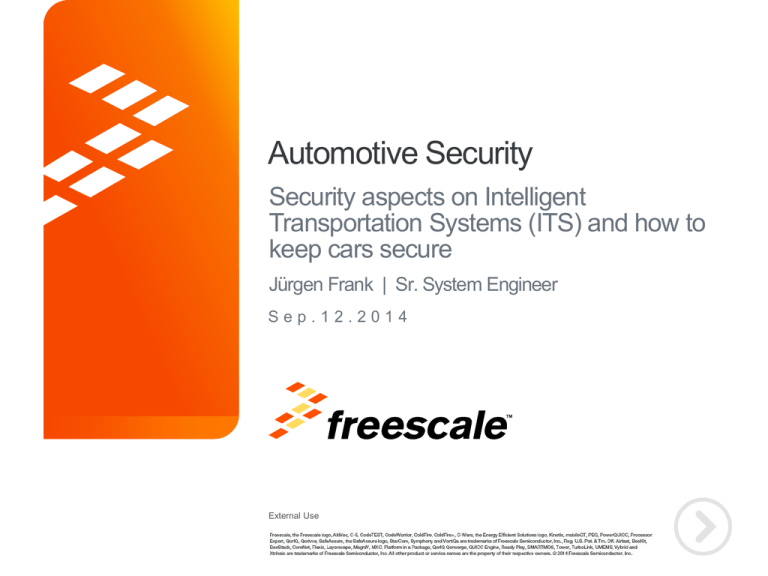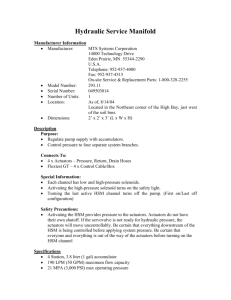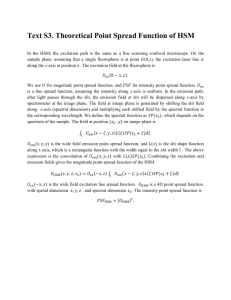Security aspects on Intelligent Transportation Systems (ITS)
advertisement

Automotive Security Security aspects on Intelligent Transportation Systems (ITS) and how to keep cars secure Jürgen Frank | Sr. System Engineer Sep.12.2014 TM External Use Agenda • Introduction − Automotive Security Use-Case − Security Timeline • Standards − EVITA − SHE − HSM − TPM • Security Modules TM External Use 1 Introduction TM External Use 2 Security Use Cases In-Vehicle Security • Immobilizer / Component Protection • Mileage Protection • Secure Boot and Chain of Trust • Secure Communication • DRM - eCars Connected Vehicle Security • Application download • DRM for content download/streaming • Remote ECU firmware update • Black-box for due government or insurance • Car-to-X communication TM External Use 3 Automotive Security - Timeline HIS HIS-SHE 1st SHE implementation MPC564x - CSE EVITA EVITA - Low/Medium/High Sec. Modules Hardware Security Module 1st device MPC5746M - HSM HIS–HSM Specification HIS - HSM CSE2 (CobraC55 / Halo) CSE2 CSE3 CSE3 Next Gen. Security Module N.G. HSM 2008 2009 2010 TM External Use 4 2011 2012 2013 2014 The Standards TM External Use 5 HIS – SHE Specification • Created by some German Car OEMs • Published as a official HIS standard (HIS => Herstellerinitiative Software, German for 'OEM software initiative') • Re-view of the Spec. by Freescale in an early phase • Key features of the SHE specification: −A secure storage for crypto keys − Crypto algorithm acceleration (AES-128) − Secure Boot mechanism to verify custom firmware after reset − Offers 19 security specific functions − Up to 10 general and 5 special purpose crypto keys juergen.frank@freescale.com TM External Use 6 Evita a project co-funded by the European Union http://www.evita-project.org The objective of EVITA is to design, verify, and prototype an architecture for automotive on-board networks where security-relevant components are protected against tampering and sensitive data are protected against compromise. High-Level Medium-Level Low-Level UTC Clock AES-128 Internal RAM Internal Core ECC-256 64 KBytes 50-250 MHz NIST FIPS GF(p) AES-PRNG EVITA HW-IF Internal NVM Sec. Counter AES based HASH 32+10 KBytes EVITA Security Modules Comment: • No OEM request EVITA modules OEMs reference to SHE or HSM • Is not a specification, it’s a guidance • Already outdated on some aspects TM External Use 7 Trusted Platform Module Auto Security TPM 1.2 TPM 2.0 Specified 2009 HIS-SHE; 2011 HSM 2003/4 TCG Spec.; 2009 ISO/IEC11889 DRAFT Target Market Automotive PC Embedded Systems, Automotive Profile available since 2 weeks Algorithm AES-128, CMAC HSM is prog. by customer RSA, SHA1, HMAC, AES (optional) RSA, ECC, SHA-1 /-256, HMAC, AES, other possible by supplier Interfaces on-die peripherals with master access and high clock ext. SPI, I²C or LPC (28 / 32 pin package) / embedded in chips sets (e.g. Ethernet) / virtualized TPM Clock CSE ≥120 MHz / HSM ≥80 MHz Typical 33 – 50 MHz Internal core SHE: SM or 32bit / HSM: 32bit mainly 8/16 bit ; rarely 32 bit Performance for 64bytes SHE/HSM SHA1 155µs (TPM with 32bit-SC300™ core) CMAC ~1µs Main arguments against TPM: 1. High costs caused by integrating an external, additional chip inside an ECU 2. Sensitivity to attacks on the communication interface between ECU application core and HSM / replacing the TPM 3. The non-existence of debug/testing interfaces if a malfunctioned device needs to be analyzed 4. The high temperature range an automotive qualified product needs to satisfy (e.g. FLASH memory) 5. Is TPM2.0 able to fulfill the Car2x performance requirements (verify signature of >1000/sec) ? TM External Use 8 NIS – National Institute of Standards • No automotive focus • Specifies most of the crypto algorithm (AES, SHA-1/2/3 etc.) • Use several time the championship approach (e.g. AES & SHE3) • Worries in the market (since Snowden), NSA- Dual_EC_DRBG issue TM External Use 9 Standards in the Regions • EMEA (mainly Germany) − EVITA Initiator: EU- funded Europe CAR companies Published via Project web-page, guide not a spec. − SHE Specification Initiator: Published via − German Car OEMs HIS (Herrsteller Initiative Software) web-page Hardware Security Module Initiator: Published: • US − − − • German Tier1 & Car OEM not public available Technical acceptance of the SHE Specification (with small enhancements) See legal issues due HIS SAE specification group HSM to complex for actual use-cases ASIA − − Re-use of the SHE and HSM TPM still in discussion TM External Use 10 Security Modules TM External Use 11 Cryptographic Services Engine (CSE) Qorivva MPC564xB/C • CSE module implements the official HIS SHESpecification • 32-bit secure core working at 120 MHz • ROM RAM AES-128 − Supported crypto modes: ECB & CBC − Throughput 100 Mbit/sec − • CSE Core INTC CSE Block Host to CSE Interrupt AES IP SkyBlue-IF Host Inter. Latency 2μs per one encoding/decoding ops INTC DEBUG JTAG CSE module interfaces: − RNG Debugger connected XBAR-IF Core FlexRay Masters XBAR NEXUS Crossbar master interface eDMA Peripheral Bridge MPU Slaves − • Configuration interface Secure „Firewall“ Secure flash blocks assigned to the CSE module. Accesses from other masters are impossible. • PRNG seed generation via TRNG • CSE Core not programmable by customer TM juergen.frank@freescale.com External Use 12 FLASH Sec. FLASH on/ off Test Interface Array Test Interface BIU PB-IF MI BIU UTI SRAM CSE2 Enhancements to CSE • Introduce new security flag per GPR-keys • Increased number of GPR-keys from 10 to 20 • Secure Boot result storage in NVM (configurable by customer) • Reset Generation on Secure Boot Fail (configurable by customer) TM juergen.frank@freescale.com External Use 13 Qorivva HSM Security Architecture Features: • Device life cycle scheme • Unique ID for each device • Debugger restrictions • Flash Protection − OTP − read / write & erase − diary to log erasing-steps SSCM: PASS: TDM: HSM: MPU: DCF: System Status Configuration Module Password And Device Security Module Tamper Detection Module Hardware Security Module Memory Protection Unit Device Configuration Format TM External Use 14 Freescale Production Customer Delivery In-Field OEM Production Failure Analysis Hardware Security Module (HSM) v1: MPC5746M / MPC5777M & v2: MPC5748G / MPC5746C HSM is free programmable by the customer, additional security algorithm could implemented in software Features: • e200z0h core (v1: 100MHz / v2: 80 MHz) • 4Kbytes Instruction cache • Secure Debugger Interface • Cryptographic Modules with AES-128, Random Number Generator, DMA • Sensor Interface – monitor for voltage, temperature and clock (v1) • Memory − SRAM (v1: 40 Kbytes / v2: 32 Kbytes) − Flash code: 2 x 64 Kbytes + 1 x 16KBytes data : 2 x 16 Kbytes juergen.frank@freescale.com TM External Use 15 Flash Reprograming Security OTP Flash (Configuration) LifeCycle State n LifeCycle State 1 LifeCycle State 0 Password 3 256 bits Password 2 256 bits Password 1 256 bits Password 0 256 bits Configuration Flash Program Enable 256 bit Challenge Register Debug Enable/Disable Flash Program Enable/Disable Write/Erase Flash (Application) Boot code (Password 0) MCAL (Password 1) Pass Module OEM Code (Password 2) Calibration (Password 3) OEM Code (Password 2) CPU MCU TM External Use 16 One Time Programable (OTP) definition: • A Flash block assigned as OTP cannot be erased. • Programming can only be done on an erased location. • Overprogramming is not possible. Erase/Pgm TDM Flash Controller DCF records TM External Use 17 i.MX Trust Architecture Features • Trusted Execution − Isolates execution of critical SW from possible malware − TrustZone® Secure & Normal Worlds (processor modes) − Hardware firewalls between CPU & DMA masters and memory & peripherals • High Assurance Boot − Authenticated boot: prevents unauthorized SW execution − Encrypted boot: protects SW confidentiality − Digital signature checks embedded in on-chip boot ROM − Run every time processor is reset • HW Cryptographic Accelerators − i.MX family dependent − Symmetric: AES-128, AES-256, 3DES, ARC4 − Message Digest & HMAC: SHA-1, SHA-256, MD-5 TM External Use 18 i.MX Trust Architecture Features (continued) • Secure Storage − Protects data confidentiality and integrity − Off-chip: cryptographic protection including device binding − On-chip: self-clearing Secure RAM − HW-only keys: no SW access • HW Random Number Generation − Ensures strong keys and protects against protocol replay − On-chip entropy generation − Cryptographically secure deterministic RNG • Secure Clock − Provides reliable time source − On-chip, separately-powered real-time clock − Protection from SW tampering TM External Use 19 i.MX Trust Architecture Features (continued) • Secure Debug − Protects against HW debug (JTAG) exploitation for: Security circumvention Reverse engineering − Three • security levels + complete JTAG disable Tamper Detection − Protects against run-time tampering − Monitoring of various alarm sources Debug activation External alarm (e.g. cover seal) SW integrity checks SW alarm flags − HW and SW tamper response TM External Use 20 CSE, HSM and the Security Standards Security Standards Main features EVITA- Low HIS-SHE EVITA-Medium (HIS-Medium) EVITA-High UID Crypto engine NVM is mandatory Fix function set Programmable by customer Public Key HASH CSE/CSE2 CSE3 HSM (v1/v2) next generation security module* *feature set, still in discussion TM External Use 21 Freescale Devices with Security Freescale Security Solution for Automotive products Device Platform MPC5746M / MPC5777M MPC5748G / MPC5746C CSE Power Architecture® e200 MPC5777C i.Mx ARM® 2x / 3x / 5x / 6x / 7x HSMv2 CSE2 ARM® Cortex®Ax/Mx & ARM9/11 TrustZone® + Sahara / CAAM no automotive standards available juergen.frank@freescale.com TM External Use 22 Consumer MPU (flashless) Vybrid ARM® Controller Solutions HSMv1 Automotive MCU ( internal flash) MPC564xB/C Module Summary • Accepted Specifiction(s) for all regions (EMEA, US and ASIA) − Actual, no international standards − Actual, no public standards • Specification of the cryptographic functions − Functions & Algorithm − Performance (bandwidth, latency) • Additional security requirements − e.g. protection schemes required TM External Use 23 TM www.Freescale.com © 2014 Freescale Semiconductor, Inc. | External Use



